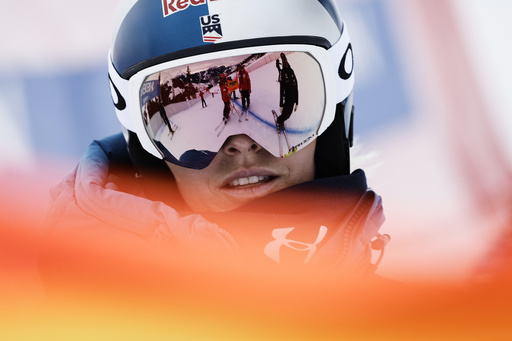
SAALBACH-HINTERGLEMM, Austria — Mikaela Shiffrin appears to be physically back in top form after enduring a serious fall, yet she acknowledges that her mental recovery is still a work in progress. This realization led her to skip the giant slalom race at the world championships, just two days after securing a gold medal in the team combined event. The two-time Olympic gold medalist openly confessed to grappling with post-traumatic stress disorder stemming from a traumatic incident during a giant slalom race on November 30 in Killington, Vermont, where a harsh impact caused significant damage to her oblique muscles.
Shiffrin feels that she is not yet prepared to face the challenges of giant slalom racing. The path to overcoming such emotional obstacles is often unclear and varies from athlete to athlete. Each skier has their own method of coping with traumatic experiences, leading to different recovery timelines, whether recovering from torn ligaments, severe cuts, or more severe injuries.
Ben Foodman, a psychotherapist specializing in performance and mental health, described the psychological aftermath of traumatic events. He emphasizes how the brain can struggle to process these experiences, likening it to having a jumbled puzzle in your memory. He noted, “When you go through a trauma, it can be overwhelming, and if care isn’t taken, individuals might feel as if they’re reliving that moment.”
Italian skier Sofia Goggia has experienced similar sentiments during her recovery from a significant knee injury. Reflecting on her own life, she expressed, “I was burdened by fear,” particularly during her training in Soelden, Austria. However, following a period of practice in Copper Mountain, Colorado, she discovered her speed and confidence returned after just ten days.
In Shiffrin’s case, she approached the slalom event of the team combined, as it did not evoke the same trepidations as the faster giant slalom. Teaming up with Breezy Johnson, who participated in the downhill segment, they collectively triumphed, bringing back a sense of her former dominance. Nonetheless, Shiffrin remains haunted by the trauma from her previous fall, explaining that she was perilously close to a catastrophic injury that day.
As she resumed on-snow training, Shiffrin found herself confronting similar sensations that had accompanied her fall. She hoped this exposure would help alleviate her fears, but the process proved more complicated than anticipated. “Although I thought skiing would bring back my passion and joy, there are numerous factors at play that complicate the experience,” she admitted.
Foodman offered an analogy to illustrate the complexity of the human brain, comparing its neural connections to grains of sand filling multiple Olympic-sized swimming pools. He stressed that athletes frequently subject themselves to stress tests, meaning that revisiting the sport often brings back unwanted memories of past injuries.
Another skier, Johnson, who recently made her own comeback after sustaining a second knee injury, recognized the mental struggle involved in returning to the sport. She conveyed how, in the absence of skiing, the mind tends to romanticize the sport, longing for the joy it once brought. Yet, upon returning, she was reminded of the sport’s inherent difficulties.
Retired ski racer Ted Ligety spoke to his own experiences with maintaining mental clarity despite physical discomfort from previous back issues. He managed to balance awareness of his injuries with the freedom required to perform well on the slopes.
Lindsey Vonn, who returned this season after nearly a six-year break, echoed a similar perspective on dealing with crashes. “I confront each incident directly. I analyze what happened, learn from it, and keep moving forward,” Vonn shared. For her, rapidly regaining confidence meant returning to the slopes almost immediately.
Each ski racer has their unique recovery journey, emphasizing the importance of becoming comfortable with discomfort during healing. Foodman suggests that athletes confront their emotions rather than ignoring them to help navigate the road to recovery. He mentions the book “The Body Keeps the Score” by Bessel van der Kolk as a valuable resource for understanding the interplay between trauma and healing.
Overall, the journey of recovery in skiing remains as diverse as the athletes themselves, highlighting the intricate relationship between mental resilience and physical performance.

